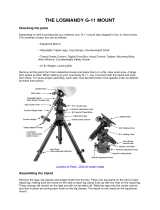
INTRODUCTION..................................................................................................................................................................................4
W
W
a
a
r
r
n
n
i
i
n
n
g
g ..............................................................................................................................................................................................4
ASSEMBLY ...........................................................................................................................................................................................6
Setting up the Tripod...........................................................................................................................................................................6
Attaching the Center Leg Brace ..........................................................................................................................................................7
Attaching the Electronics Pier.............................................................................................................................................................7
Attaching the Equatorial Mount..........................................................................................................................................................8
Installing the Counterweight Bar ........................................................................................................................................................8
Installing the Counterweight ...............................................................................................................................................................8
Attaching the Optical Tube to the Mount............................................................................................................................................9
Attaching the Visual Back...................................................................................................................................................................9
Installing the Star Diagonal...............................................................................................................................................................10
Installing the Eyepiece......................................................................................................................................................................10
Installing the Finderscope .................................................................................................................................................................11
Moving the Telescope Manually.......................................................................................................................................................12
Adjusting the Mount .........................................................................................................................................................................12
Balancing The Mount in R.A. ...........................................................................................................................................................13
Balancing The Mount in DEC...........................................................................................................................................................13
Attaching the Motor Cables ..............................................................................................................................................................14
Powering the Telescope ....................................................................................................................................................................14
Transporting the CGE .......................................................................................................................................................................14
HAND CONTROL...............................................................................................................................................................................16
Named Stars ......................................................................................................................................................................................17
Hand Control Operation ....................................................................................................................................................................17
Alignment Procedures.......................................................................................................................................................................18
Startup Procedure..............................................................................................................................................................................18
Auto Two-Star Align ........................................................................................................................................................................19
Auto One-Star Align .........................................................................................................................................................................19
Quick-Align ......................................................................................................................................................................................20
Last Alignment .................................................................................................................................................................................20
CGE Re-Alignment...........................................................................................................................................................................20
Object Catalog ..................................................................................................................................................................................21
Selecting an Object............................................................................................................................................................................21
Slewing to an Object .........................................................................................................................................................................21
Finding Planets..................................................................................................................................................................................21
Tour Mode.........................................................................................................................................................................................22
Constellation Tour.............................................................................................................................................................................22
Direction Buttons ..............................................................................................................................................................................22
Rate Button........................................................................................................................................................................................22
Setup Procedures...............................................................................................................................................................................23
Tracking Mode........................................................................................................................................................................23
Tracking Rate..........................................................................................................................................................................23
Date/Time ...............................................................................................................................................................................23
User Defined Objects ..............................................................................................................................................................24
Get RA/DEC ...........................................................................................................................................................................24
Goto R.A/Dec..........................................................................................................................................................................24
Identify....................................................................................................................................................................................24
Precise GoTo .....................................................................................................................................................................................25
Scope Setup Features.........................................................................................................................................................................25
Steup Time-Site.......................................................................................................................................................................25
Anti-backlash ..........................................................................................................................................................................25
Filter Limits ............................................................................................................................................................................26
Direction Buttons ....................................................................................................................................................................26
Goto Approach........................................................................................................................................................................26
Autoguide Rates......................................................................................................................................................................26
Mount Settings ........................................................................................................................................................................26
Utility Features..................................................................................................................................................................................27
Calibrate Mount ......................................................................................................................................................................27
Move to Switch .......................................................................................................................................................................27
Home Position.........................................................................................................................................................................27
Polar Align..............................................................................................................................................................................27
Periodic Error Correction ........................................................................................................................................................28
Light Control...........................................................................................................................................................................28
Factory Settings.......................................................................................................................................................................28
Version....................................................................................................................................................................................28
Get Alt-Az...............................................................................................................................................................................28




















